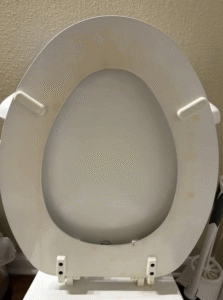Getting rid of a yellow toilet ring without replacing the seat may sound like a challenge, but with the right approach, it’s completely doable. I faced this issue myself—after years of use, my toilet seat developed an unsightly yellow ring that just wouldn’t budge with regular cleaning. I thought I’d have to buy a new seat, but after some trial and error, I discovered a solution that worked surprisingly well. Here’s how I did it.
First, I identified the cause. The yellow ring wasn’t just from dirt or stains—it was likely a combination of hard water minerals, urine residue, and aging plastic. Standard bathroom cleaners helped a little but didn’t remove the stain entirely. So I needed something a bit more powerful, but still safe for both the toilet seat and my hands.
Step one was a simple homemade paste using baking soda and hydrogen peroxide. I mixed about 1/2 cup of baking soda with enough hydrogen peroxide to form a thick paste. Wearing gloves, I applied the paste generously around the ring and gently rubbed it in using a non-abrasive sponge. I let the mixture sit for about 30 minutes. This combination has gentle whitening power and lifts stains without damaging plastic.
After letting it soak, I scrubbed the area again and rinsed it clean. There was a noticeable improvement, but the ring wasn’t completely gone. I repeated the process a second time, this time letting the paste sit for closer to an hour. When I scrubbed and rinsed it again, I saw the stain fade even more.
Still not satisfied, I looked for a stronger but still safe option. That’s when I tried distilled white vinegar. I soaked a few paper towels in white vinegar and laid them directly over the stained area. Then I covered the whole seat with plastic wrap to keep the moisture from evaporating too quickly. I left it for several hours—about three to four. When I removed the wrap and towels and scrubbed the area with a sponge, the yellowing was almost entirely gone.
For the finishing touch, I made a paste using Bar Keepers Friend, which is a mild abrasive cleaner. I applied it only to the most stubborn spots using a soft cloth. I gently buffed the stain in circular motions and let the cleaner sit for a few minutes. After rinsing it thoroughly and drying the seat, I was stunned—the yellow ring had disappeared. The toilet seat looked nearly new, smooth, and clean, with no discoloration left.
Throughout this process, I avoided anything overly abrasive like steel wool, which could scratch or damage the seat permanently. I also skipped bleach, which can discolor plastic over time and cause further yellowing. The key was using a combination of safe, household items—baking soda, hydrogen peroxide, vinegar, and a little Bar Keepers Friend—to target the stain without harming the surface.
Now, I make sure to maintain the seat regularly. I wipe it down once a week with a mix of vinegar and water, and I dry it after cleaning. This helps prevent the build-up of minerals or moisture that can lead to staining. And when I notice the beginning of a yellow tint, I address it right away with the baking soda paste before it becomes too tough.
Getting rid of a yellow toilet ring isn’t about throwing away the whole seat—it’s about persistence and the right techniques. I didn’t spend much money, I didn’t need fancy cleaners, and I didn’t have to replace anything. Just a few items from the kitchen and a bit of elbow grease brought my toilet seat back to life. If you’re facing the same issue, try this method before resorting to buying a new one. It really worked for me.


